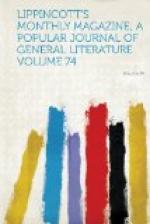[Illustration: MEXICAN INTERIOR.]
Pueblo, while not a representative Western town in these respects, yet in its early days presented some curious combinations, most of them growing out of the heterogeneous human mixture that attempted to form a settlement. The famous Green-Russell party, on its way from Georgia to the Pike’s Peak country, had passed through Missouri and Kansas in 1858, and there found an element ripe for any daring and adventurous deeds in unknown lands. Many of the border desperadoes, then engaged in that hard-fought prelude to the civil war, found it desirable and expedient to leave a place where their violent deeds became too well known; and these, together with others who hoped to find in a new country relief from the anarchy which reigned at home, fell into the wake of the pioneers. Pueblo received its full share of Kansas outlaws about this time, and, what with those it already contained, even a modicum of peace seemed out of the question. Here, for instance, was found living with the Mexicans by the plaza a quarrelsome fellow named Juan Trujillo, better known by the sobriquet of Juan Chiquito or “Little John,” which his diminutive stature had earned for him. This worthy is represented as a constant disturber of the peace, and he met the tragic fate which his reckless life had invited. From being a trusted friend he had incurred the enmitv of a noted character named Charley Antobees, than whom, perhaps, no one has had a more varied frontier experience. Coming to the Rocky Mountains in 1836 in the employ of the American Fur Company, he has since served as hunter, trapper, Indian-fighter, guide to several




